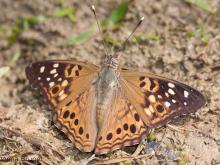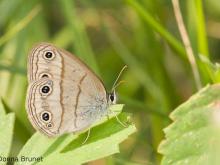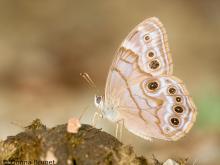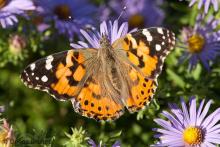Butterflies and Moths
Media

Species Types
Scientific Name
Megalographa biloba (formerly Autographa biloba)
Description
The bilobed looper moth has a conspicuous B-shaped silvery spot on each forewing. Caterpillars of this noctuid moth eat a wide range of plants, and this species is widespread.
Media

Species Types
Scientific Name
Halysidota tessellaris
Description
Adult banded tussock moths have a distinctive checkered pattern on the wings. The fuzzy, dirty gray caterpillars are more familiar, with their pencils or tussocks of longer, black and white hairs.
Media

Species Types
Scientific Name
More than 12,000 species in North America north of Mexico
Description
Learn about moths as a group. What makes a moth a moth? How are moths different from butterflies? What are the major groups of moths?
Media

Species Types
Scientific Name
Polygonia progne
Description
The gray comma is easy to ID if you can see the underside: it is charcoal gray with many fine dark streaks, and its comma marking is L-shaped and narrows to a fine point at each end.
Media

Species Types
Scientific Name
Asterocampa celtis
Description
The hackberry emperor eats hackberry leaves as a caterpillar. The adults fly erratically. They often alight on people to absorb sodium from sweat.
Media

Species Types
Scientific Name
Megisto cymela
Description
The little wood satyr is an abundant butterfly found in Missouri’s open woodlands and brushy fields. Its bouncing flight has been called “skipping.”
Media

Species Types
Scientific Name
Enodia anthedon (syn. Lethe anthedon)
Description
The northern pearly-eye is grayish brown with dark eyespots. Of three pearly-eye species in Missouri, it is the most widespread.
Media

Species Types
Scientific Name
Vanessa cardui
Description
The painted lady is a delicately patterned butterfly found nearly worldwide. It migrates to Missouri in spring. There are several broods.
Media

Species Types
Scientific Name
Phyciodes tharos
Description
Don't let the pearl crescent’s dainty size keep you from admiring its intricate beauty.
Media

Species Types
Scientific Name
Polygonia interrogationis
Description
The question mark is named for the shape of the small silver mark on the lower side of the hindwings. It flies in Missouri April to November.
See Also


Media

Species Types
Scientific Name
About 1,500 species in North America north of Mexico
Description
Adult caddisflies are mothlike. Their larvae are aquatic and build portable, protective cases out of local materials, including grains of sand, bits of leaves and twigs, and other debris.
Media

Species Types
Scientific Name
Corydalus cornutus
Description
Adult eastern dobsonflies are huge and mothlike, with large wings and a weak, fluttery flight. The fiercely predaceous aquatic larvae, called hellgrammites, are well-known to anglers, who often use them as bait.
About Butterflies and Moths in Missouri
Butterflies, skippers, and moths belong to an insect order called the Lepidoptera — the "scale-winged" insects. These living jewels have tiny, overlapping scales that cover their wings like shingles. The scales, whether muted or colorful, seem dusty if they rub off on your fingers. Many butterflies and moths are associated with particular types of food plants, which their caterpillars must eat in order to survive.





















